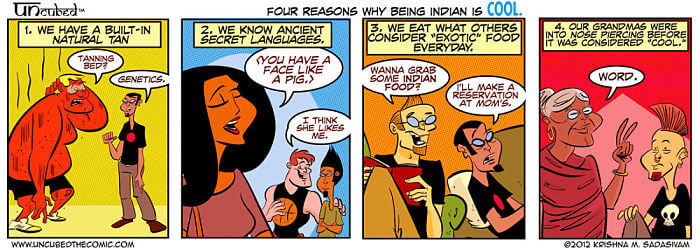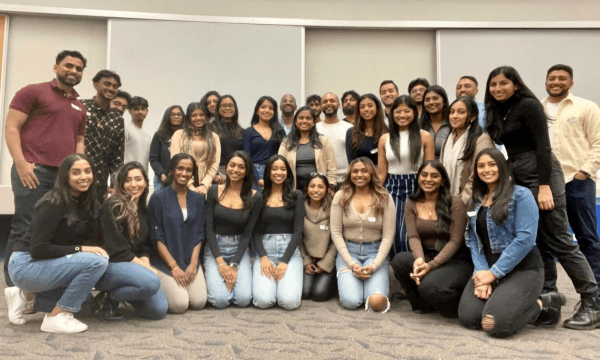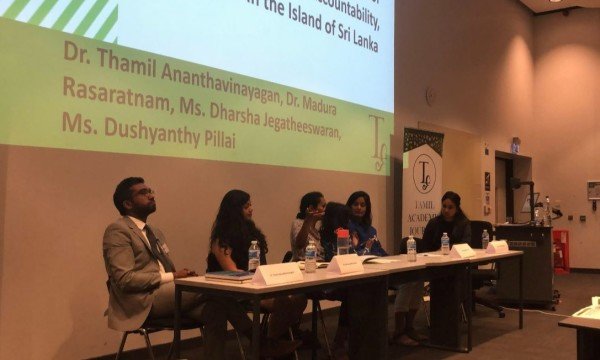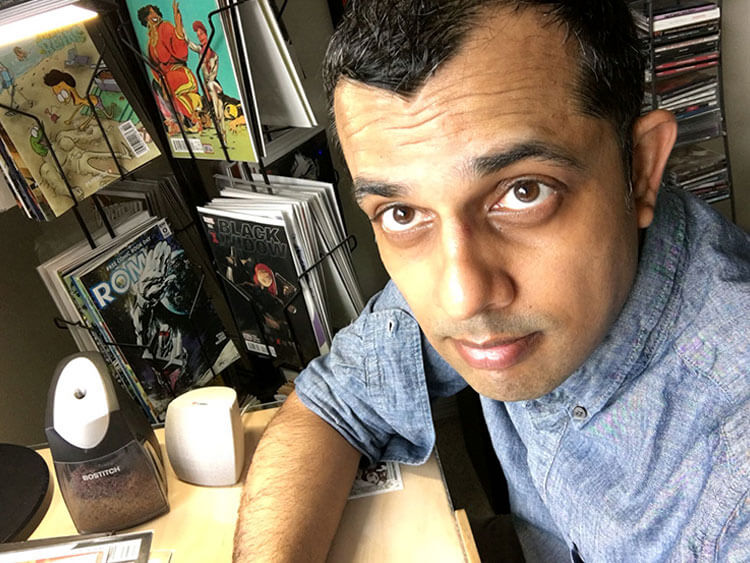
TC: Tell us a bit about yourself.
Krishna Sadasivam:I was born in Canada and I have been living in the United States since I was seven years old. My parents initially immigrated from India. They lived in England for a while so by the time they had me, they had already settled down in North America. In terms of my background, when I was a child, I always knew that I wanted to draw and create. I was a huge fan of cartoons and that was the thing that was my big obsession. When I was looking to go to college, I definitely expressed my interest in art. My parents were coming from a very conservative South Indian background, and were concerned about what everyone else would say about my choice. They encouraged me to go into engineering because I liked computers so much. So I went into engineering and earned my Bachelors and Masters at the University of Tennessee in Knoxville. After graduation, I worked as a chip designer for four years. All the while, the bug for cartooning and drawing was always within me. I would gather whatever books I could find and collect as much information as I could. Growing up as a kid, there always seemed like there weren’t that many resources. For example, as a child I would always gravitate towards the art section when I went to the library, in the hopes of finding books on cartooning. Maybe, If I was lucky, I would find one or two. Graphic novels and comic books just weren’t things you would find in a library.
I think that a lot of kids come from this type of situation, where they have an idea of what they want to do ,and it may get stifled out of them over time. After working for four years, the dot com bubble burst and a lot of companies started to open up offices over seas. Instead of accepting the job offers that came my way, I took this opportunity to go back to school. I went to the Savannah college of Art and Design and I studied Animation. Now I have my MFA in Animation from SCAD and while I was studying, I did a lot of free lance work. Initially, my big break came from CNET, a company that does tech publications. I did a cold call to the editor and asked him for feedback on my comic, PC Weenies, which I launched in 1998. I was naïve but I figured that I had nothing to lose. Fortunately for me, he was very accommodating and liked the comics. PC Weenies ran on CNET for a few months, and a publishing company overseas saw them on CNET and reached out to me to ask if they could run them in their magazine every month… and they were willing to pay me for it. This relationship lasted for three years. So, I have been making comics on and off at pcweenies.com for 19 years!
TC: Can you describe the premise behind your famous comic PC Weenies?
KS: It is basically a tech comic with a heavy dose of geek, computer science and engineering humour. You don’t have to be an engineer or software developer to enjoy it, but it doesn’t hurt. The premise of the comic follows a little short guy named Bob Weiner who is an IT/Developer for a company called Foodle, which rhymes a lot with another company that we all know of. The only problem with this company is that they are completely incompetent. They’re making money but they like to goof off. So Bob has been put in a situation where he has to manage 3 or 4 other employees. I’ve always enjoyed creating his surrounding cast to have some Indian leads. These characters are amalgams of people that I have known in the past. There is one character called Up Chuck, and he couldn’t code to save his life. Another character named Vindaloo, is the all-time slacker, and he was recently let go in the comic. I publish the strip twice a week on Mondays and Thursdays and there is about 9 years worth of comics on the website.
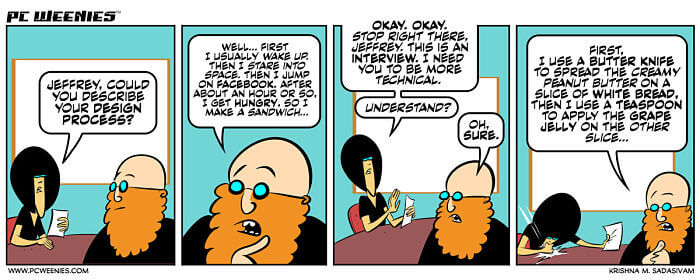
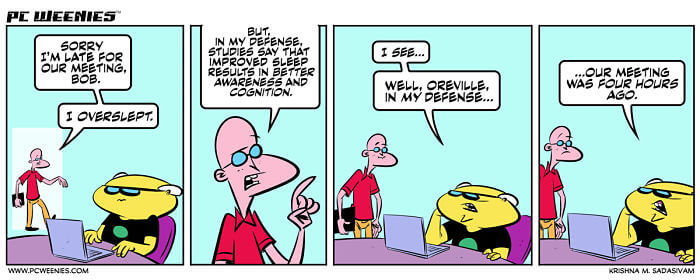
TC: Why was it important for you personally to include cultural aspects in your comics?
KS: I always wanted characters that I could relate to. There have been a lot of comparisons between PC Weenies and the comic Dilbert, and I get that because on the surface they are both about characters that work in an office. However, I really wanted to go a little bit beyond the typical ideals and dial into something that is a little more authentic and subversive; where the person who is the Manager is actually not incompetent. In my comic, the Manager has to deal with crazy employees and through this medium, I get to create the fantasy of being able to say or do whatever you want because you are really smart and you can do it. This is something I have always personally wished that I could do, so the process is very cathartic. Having Indian leads in the strip always felt very natural. I have a daughter that is 9 years old right now and she is actually my proof reader and test subject for my comics. I will show my ideas to her and ask for her unvarnished opinion. She likes computers and her Ipad, but she’s not heavily invested in the stuff, so my test is that if she can get it and if she laughs then I choose that one to go up on the internet. But if she has a question or she’s not sure, then I know I have to tweak the comic more. At the end of the day, I really write them for her so I want the comics to resonate, not only for adults, but kids too.
TC: What attracted to you at a young age to illustrations and cartoons and why didn’t you keep it as just a hobby?
KS: Cartoons were kind of my surrogate babysitter growing up, so it was something that I fell into. I am not completely sure why I liked them more than anything else, but I have always loved to draw since I was a child so seeing things that were drawn on the screen was really novel to me. When I was 4 years old, my parents bought me some comic books that featured the characters that were in my cartoons. This opened up a lot of doors for me when it came to visual story telling. I didn’t know much about animation back then, but I was starting to learn how to read at the time and I was motivated to learn to read better so that I could understand what the comic books were actually saying. Just the idea of telling stories visually really resonated with me. I choose to do this professionally because I think that you only have one shot at life, so just have fun and do the things that you want to do. At first it was scary and many people that I spoke to at that time thought I was crazy because I was getting offers to go work for different engineering companies but I wanted to see if this was something that I could go off and do. I knew that if I didn’t pursue this path, I would always look back with regret. My advice is to just do it! Don’t worry if someone else can or can’t do it. You just have to go for it. There is always going to be an audience for your work, you just have to try. It might take a while, but you have to be persistent.
TC: How did you start to pursue illustrations as a career and how did you gain experience?
KS: Everyone has a different way to enter this industry. The creative field has numerous paths and they way that I got in was approaching companies that I knew would be a good target fit for the type of work that I was doing. When you are writing, you are writing not only for yourself, but you are also thinking of an audience. My advice is to make a lot of cold calls and emails and expect a lot of rejection. At one point, years and years ago I sent out a syndication package to get published in the newspapers and like many other cartoonists, I received a rejection letter. At that time if kind of stung a little bit, but in the end, I think that publishing online gives me the widest audience to work from. I would advise others with a similar interest to keep at it and don’t pay attention to things that can discourage or dissuade you. My first professional gig was the “What PC Magazine” and this experience really opened my eyes. The moment you get money from someone that is not your parents or relatives for doing work, you start to feel a little bit more empowered. Really a lot of my jobs came from having a web presence, posting work and being consistent. I would publish three comics a week on Mondays, Wednesdays and Fridays and I did that while holding down a day job. I made my evenings dedicated towards my craft. A lot of people will watch tv and zone out after work. I definitely felt like doing that but I also knew that I really loved what I was creating, and if I didn’t do it now, when would I do it? Persistence, going to different networking events to meet people, utilizing social media and having a web presence were all integral to my success.
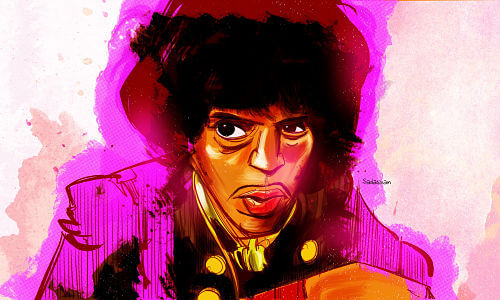
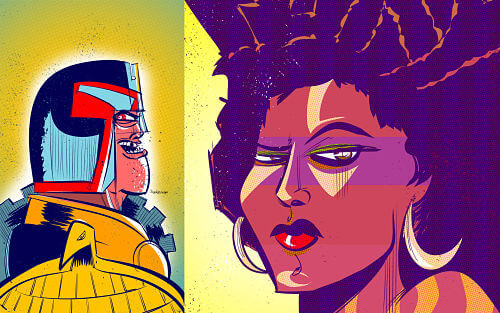
TC: How as technology impacted your craft?
KS: It has a pretty sizeable impact because everything that I do, from creating the comic or writing the blog post, is all done on my computer. To draw on the computer, I use a tablet monitor that I can draw on directly in conjunction with a program called Clip Studio paint. It is a very affordable option for people who are just getting interested in cartooning to play around with. It is a little different from drawing on paper because the surface is textured but not in the same way as paper, so it takes a little bit of getting used to. But when you can see what you are drawing on the screen, it really makes a huge difference. I think that little kids take to this software very easily. The next suggestion I would make is to look at the Ipad pro. That, in conjunction with the apple pencil, is a very nice portable drawing tool. I choose this option when I cannot lug heavy hardware back and forth to certain places.
TC: What is the opportunity that you are most proud of and how did this define your career?
KS: The defining moment of my career was when I was one of seven cartoonists asked by the Smithsonian Museum of American History to research and draw comics that profiled prominent Asian Americans and how they had to fight to get their citizenship within in this country. I have no idea how my name was put forth, but whoever was responsible for this, I am very grateful and thankful to them. Initially when I got the note, I was a little bit skeptical because I thought it was a spam mail. But I decided to respond anyway and it turned out to be the real deal. This opportunity was part of a travelling road show that went across the country and was in the Smithsonian Museum of American History. This was a project I was honoured to be asked to do and I feel that my work for this exhibit will make an impact because I believe that comics can be used as an educational tool. This is evident by the fact that they are using comics to provide different perspectives and add a new dimension to telling the story of these individuals who played such a huge role in shaping our country today.
TC: What is the key to your success?
KS: I think that success is just a combination of hard work, consistency and the ability to be persistent over and over again. At some point people may think you’re crazy and you feel like you want to give up, but if you just keep sticking with it and you keep practicing, you will get better. I tell this to my daughter all the the time because she looks at what I’m doing and says “Daddy I can’t draw that well”, but I tell her that everyone that is born does not come out with a pencil in their hand. They have to practice! I show her some of my old drawings to reinforce that everyone goes through this process. Even the best artists in the whole planet, at one point felt that they couldn’t draw well enough and maybe they still feel that way but they still kept sticking with it. That ‘Stick-to-it-ive-ness’ is a really important thing. Don’t give up, keep at it and surround yourself with other positive people who do the same thing or have the same mindset. This provides a great resource and Oasis where you can recharge your batteries. When you talk to people who get what you do, this naturally motivates you and gets you excited about what you are currently doing.
TC: Who supported you when you started out with your career?
KS: Initially my mom was on the fence about it. But when she started to follow my career and see my success, she warmed herself up to what I was doing. She told me recently that she was very proud of what I was able to do, so I feel very happy about that. Most Indian parents are stoic and are reluctant to say anything that might be deemed as a compliment. So when she said it, I really listened and appreciated her words. My wife Aarti, has also been a tremendous source of support too. I’ve been creating comics even before I met her, so she has been through all the ups and downs. She has always been my champion. I look up to her because she has accomplished so much in her career and her own life too, so we are each other’s cheerleaders.
TC: What inspires you and continues to fuel your passion?
KS: I am inspired by so many amazing artists out there. I don’t think we have ever lived in a time where we have had the opportunity to be bombarded by so much amazing art work, especially on Instagram and twitter. I think that it is the perpetual sense of all this great art that always gets me inspired to go ahead and jump back onto the drawing board. On a personal note, I love what I do and I love to make people happy. Through my career, I have been able to make some new friends and help people in different parts of the world that might be feeling down. I have certainly received my share of notes where a random stranger tells me that they were feeling pretty depressed, and then read my comic, which caused them to laugh out loud, so thank you so much for that. It is really neat to see that something that you are doing in the comfort of your own home is actually affecting people in a very positive way. I am grateful for the opportunity to make people happy and make them laugh. I am also an educator and that really shapes what I do as well. I would like to be able to keep doing professional work and be able to bring that into the classroom.
TC: What would be your advice for aspiring individuals who share a similar passion?
KS: If you can, find someone to be your mentor. This should be a trusted source that has been through the experiences you are about to go through. Someone who can give you advice, show you the ropes, encourage you, uplift you and make you a better artist or designer. If we all found a mentor early on in life, this would be a really rare thing. Do your research and understand that everyone is busy, but if someone can make time for you and help you out, take it as a huge gift. My other advice is a quote from Jack Kirby “Done is better than perfect”. He is one of the most prominent comic book artists on the planet. He only rose to big prominence when he developed the Marvel Universe as a 44 year old man. So just do it, make it and don’t worry about it being perfect.
Do you want to know more about Krishna and his work? Visit his website and add him on social media!
Portfolio: krishnadraws.com
Instagram: @krishnadraws
Product reviews: pcweenies.com
